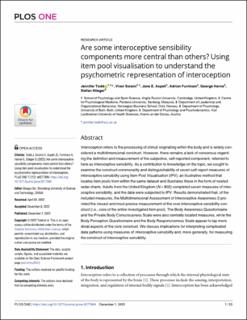| dc.contributor.author | Todd, Jennifer | |
| dc.contributor.author | Swami, Viren | |
| dc.contributor.author | Aspell, Jane E. | |
| dc.contributor.author | Furnham, Adrian | |
| dc.contributor.author | Horne, George | |
| dc.contributor.author | Stieger, Stefan | |
| dc.date.accessioned | 2023-01-23T13:00:55Z | |
| dc.date.available | 2023-01-23T13:00:55Z | |
| dc.date.created | 2022-12-19T08:32:57Z | |
| dc.date.issued | 2022 | |
| dc.identifier.citation | PLOS ONE. 2022, 17 (12), . | en_US |
| dc.identifier.issn | 1932-6203 | |
| dc.identifier.uri | https://hdl.handle.net/11250/3045360 | |
| dc.description.abstract | Interoception refers to the processing of stimuli originating within the body and is widely considered a multidimensional construct. However, there remains a lack of consensus regarding the definition and measurement of the subjective, self-reported component, referred to here as interoceptive sensibility. As a contribution to knowledge on the topic, we sought to examine the construct commonality and distinguishability of seven self-report measures of interoceptive sensibility using Item Pool Visualisation (IPV), an illustrative method that locates item pools from within the same dataset and illustrates these in the form of nested radar charts. Adults from the United Kingdom (N = 802) completed seven measures of interoceptive sensibility, and the data were subjected to IPV. Results demonstrated that, of the included measures, the Multidimensional Assessment of Interoceptive Awareness-2 provided the closest and most precise measurement of the core interoceptive sensibility construct (i.e., core of the entire investigated item pool). The Body Awareness Questionnaire and the Private Body Consciousness Scale were also centrally located measures, while the Body Perception Questionnaire and the Body Responsiveness Scale appear to tap more distal aspects of the core construct. We discuss implications for interpreting complicated data patterns using measures of interoceptive sensibility and, more generally, for measuring the construct of interoceptive sensibility. | en_US |
| dc.language.iso | eng | en_US |
| dc.publisher | PLOS ONE | en_US |
| dc.rights | Navngivelse 4.0 Internasjonal | * |
| dc.rights.uri | http://creativecommons.org/licenses/by/4.0/deed.no | * |
| dc.subject | crisis-induced learning | en_US |
| dc.subject | resilience engineering | en_US |
| dc.subject | case studies | en_US |
| dc.subject | adaptive capacity | en_US |
| dc.title | Are some interoceptive sensibility components more central than others? Using item pool visualisation to understand the psychometric representation of interoception | en_US |
| dc.title.alternative | Are some interoceptive sensibility components more central than others? Using item pool visualisation to understand the psychometric representation of interoception | en_US |
| dc.type | Peer reviewed | en_US |
| dc.type | Journal article | en_US |
| dc.description.version | publishedVersion | en_US |
| dc.source.pagenumber | 23 | en_US |
| dc.source.volume | 17 | en_US |
| dc.source.journal | PLOS ONE | en_US |
| dc.source.issue | 12 | en_US |
| dc.identifier.doi | 10.1371/journal.pone.0277894 | |
| dc.identifier.cristin | 2094911 | |
| cristin.ispublished | true | |
| cristin.fulltext | original | |
| cristin.qualitycode | 1 | |

